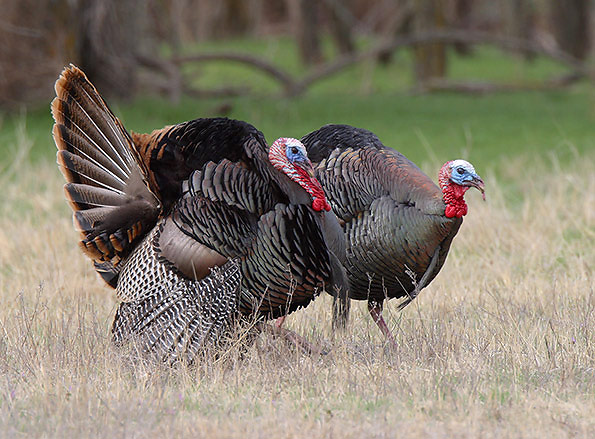- Humans aren't the only ones to gather in large groups; turkeys can be found in large flocks as well, consisting of one dominant male (called a tom) and several females (called hens) and their young.
- And speaking of young, baby turkeys are called poults and are extremely adorable.
Admit it, you're totally thinking "D'awww" right now.
- Male and some female turkeys have beards, which contrary to their appearance, are made of modified feathers, not hair.
- When strutting their stuff for a female, males not only spread their tails, but they also drag their wings on the ground (which sounds pretty impressive on pavement as I discovered), and the skin on their head changes from red to blue.
A couple of toms strutting (note the beards)
- That gizzard that you just removed from the turkey? That is one powerful muscle that you now hold in your hands. The gizzard is an organ of digestion, and is especially powerful in birds that consume seeds and nuts. Hickory nuts that normally require 124 to 336 pounds of pressure to break are completely shattered by a turkey gizzard in just over one day. Another study found that even steel is not immune to the forces of the gizzard--12 steel needles were ground to pieces by a turkey's gizzard in just 36 hours, with no damage to the turkey! Now put that gizzard down; you're dripping juices on your keyboard.
- There is only one other kind of turkey in the world, the ocellated turkey, which can be found in the Yucatan Peninsula.
Quite the handsome fellow, hua? The turkeys clearly won the plumage lottery.
- And despite their large size, turkeys can not only run 25 mph, but can fly 55mph! Ever see a turkey in a tree?
And yet more poult cuteness. Poults can fly at just 8-10 days old!
There you have it, more turkey trivia than your family members will be able to tolerate around the dinner table this Thursday (hey, just be glad I didn't tell you how to tell male and female turkeys apart just by their poo).
Have a very happy Thanksgiving, everyone!




Looking forward to turkey lunch and dinner on Thursday.
ReplyDeletei love this safe bloggy table
ReplyDelete